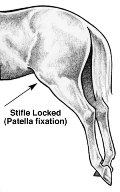 When a horse is at rest, its stifle is locked into a weight-bearing capacity. When this locking occurs, the medial patella ligament fastens over the end of the femur. When the horse goes to move, this patella ligament must unfasten. Stifle lock occurs when the ligament becomes stuck.
When a horse is at rest, its stifle is locked into a weight-bearing capacity. When this locking occurs, the medial patella ligament fastens over the end of the femur. When the horse goes to move, this patella ligament must unfasten. Stifle lock occurs when the ligament becomes stuck.
Cause of Stifle Lock
Whilst the direct cause for stifle lock is still being researched, many feel it is a hereditary condition. Factors which influence its likelihood include muscular condition (particularly quadriceps), conformation, lack of fitness, and immaturity. Injury may also lead to a breakdown of the unlocking mechanism of this joint.
Symptoms of Stifle Lock
Stifle lock in its more chronic forms may present as the horse’s leg extending out and backwards, with its fetlock resting on the ground. This is quite an obvious symptom, although horses can suffer from milder forms of this condition and not have the obvious extension. In some milder cases the horse’s stifle locks intermittently when the horse is moving, occurring with greater frequency if the horse has been at rest for some time. This may be observed when the horse in slowing down in gait, say from canter to trot. The hind leg will appear to collapse briefly, the stifle often unlocking itself with a loud click. In its most mild form stifle lock can be quite difficult to diagnose. It may appear as a slight shaking or vibration of the hind as the ligament unlocks itself, a mechanism which may be unnoticeable to many riders or onlookers.
A stifle locking often may result in inflammation, damage to the ligaments, and osteoarthritis. Lameness may then result from such ailments.
Diagnoses of Stifle Lock
If a horse were to present with lameness, stifle lock would not be the first thing on your vet’s list until a gait analyses has been performed. After ascertaining that a locking ligament problem is presenting, x-rays may be recommended to rule out other causes, also to check for wear and damage to the joint.
Treatment of Stifle Lock
In many cases the first thing your vet would recommend would be to exercise the horse. An improvement of quadriceps muscle condition often results in the stifle unlocking correctly, for milder cases. Corrective farriery is also implemented, to properly balance the breakover of the foot. Your vet would advise on a suitable exercise regime, as well as work with your farrier (often through the use of xrays) to achieve an optimal hoof conformation.
For more severe cases, surgery is sometimes suggested. There are a few different surgical techniques, your surgeon and vet will be able to suggest what could be more successful for each case. They may have to have some surgeries a second time later in life to ensure a more permanent result. Recovery time from most stifle lock surgeries is recommended to be at least three or more months, with extremely close veterinary supervision paramount.
Prognosis for Stifle Lock
With modern veterinary advancements, most cases of stifle lock can have a favourable outcome, through either more conservative exercise therapy, or via surgery.
It is key that horseowners seek a highly experienced equine veterinarian’s opinion on possible stifle lock, as many other conditions present in a similar fashion. In some cases their vet may refer them to another vet, often a specialist, for a definitive diagnosis, especially before commencing surgery.
If you are concerned your horse has a gait or lameness problem, please do not hesitate in phoning VEVS on 5543 1213.










